Why do you need to finish it?
The question of what a house basement is is still a hot topic for discussion – some consider it the top of the foundation, others – the base of the wall. Everyone is right: the basement is an intermediate structure between the load-bearing partitions and the underground base.
To choose the most suitable finish for the basement, you should understand the main functions of this architectural element:
- Load-bearing. Distributes the load from the walls above.
- Supporting. The basement serves as additional support for the entire house, guarantees the stability of vertical partitions.
- Insulating. Solves the issue of thermal insulation of premises, waterproofing.
- Decorative. Creates a perfect picture of the house from the outside.
Based on the above, we can understand that the finishing of the base is not only decoration, but also functionality. The material for finishing the base must necessarily have mechanical strength, resistance to water and temperature fluctuations. It is also desirable to enhance the hydro-, heat-insulating properties, increase the service life of the foundation, protect the base from the effects of destructive factors.
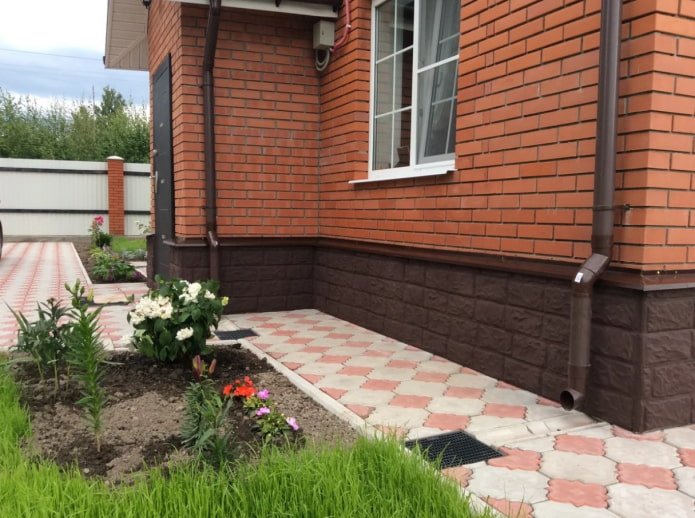
Finishing options
There are many methods of decorative finishing of the base that meet the above requirements. To choose what to sheathe, you should know the advantages, disadvantages and specifics of using each material.
Brick
Brickwork is a universal, often used option for finishing the basement. This design looks solid, is inexpensive, 100% protects the foundation from rain, snow, and the scorching sun.
The main thing in this process is to responsibly approach the choice of the brick itself:
- a monolithic concrete foundation can be sheathed with standard building bricks;
- for strip or columnar ones, finishing bricks are required, they are thinner and lighter than ordinary ones, which reduces the load on the foundation.
When choosing a brick, pay attention to its properties: the material must be water- and frost-resistant, as well as durable – because it will have to withstand serious pressure.
The advantages of brick cladding, in addition to its presentable appearance, include a long service life, resistance to aggressive environmental factors and high loads.
Among the disadvantages – brick is more expensive than most analogues, the standard one requires a solid foundation.
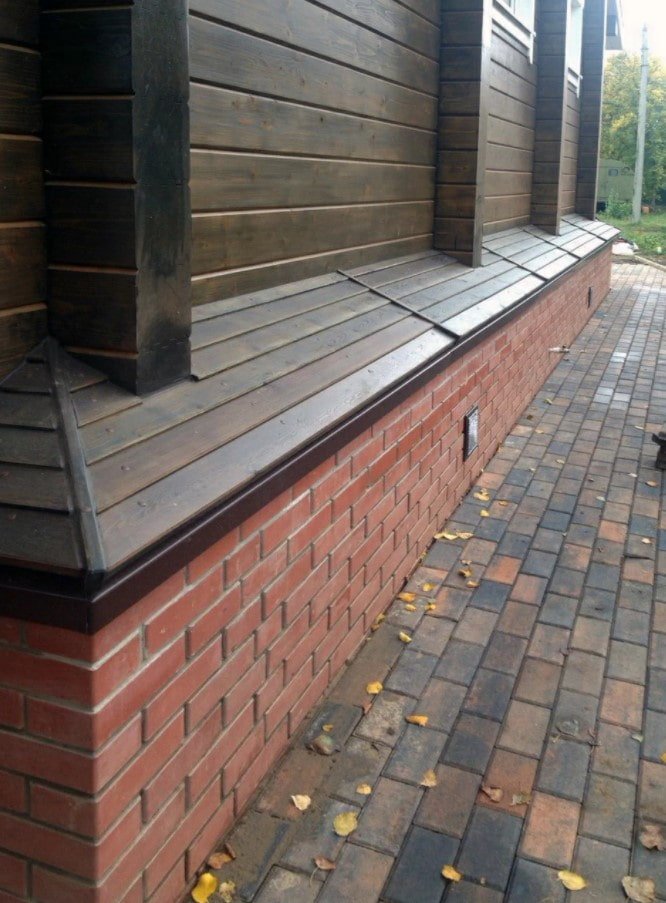
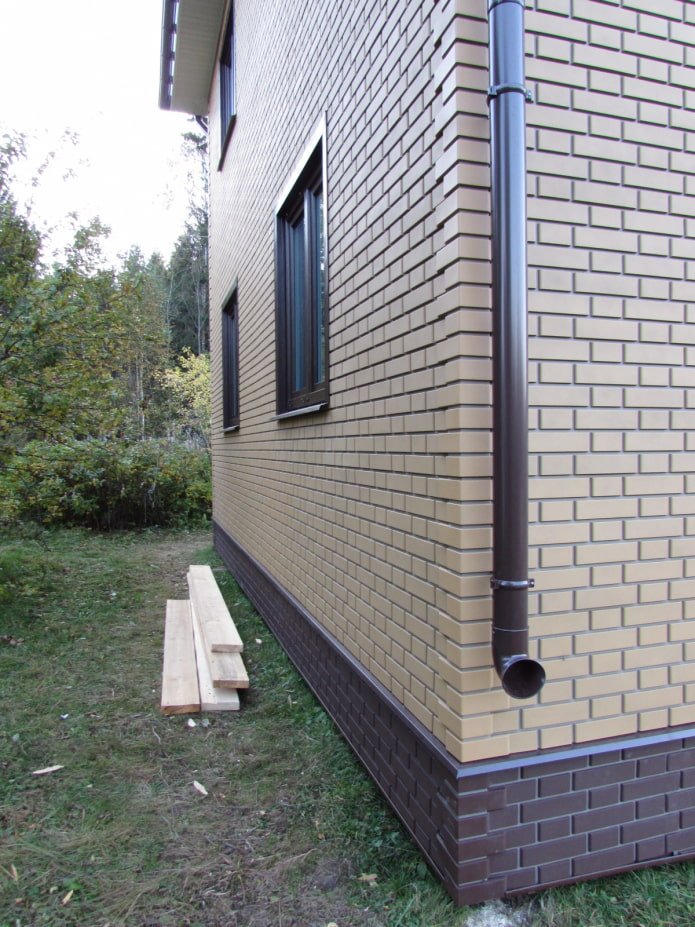
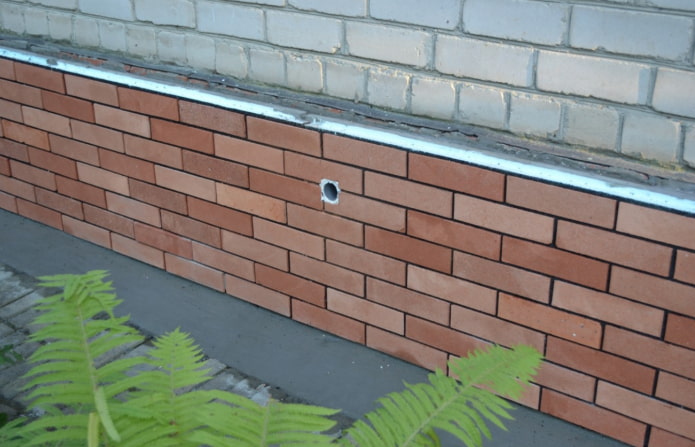
The photo shows a neat brick basement
Siding
The so-called basement siding is panels that imitate various materials: brick, stone, wood, metal. Facade panels are used not only for cladding the base: they are used to decorate the walls from the roof to the ground, so this method is suitable for those who do not want the base to stand out against the background of the house.
In general terms, the advantages of decorating the base with siding include durability (the declared service life is ~50 years), resistance to weather conditions, resistance to the development of fungus and corrosion.
The disadvantages include the need for additional thermal insulation, the possibility of damage to the panels (especially those made from PVC).
The exact characteristics depend on the specific type of cladding siding:
- Metal. Galvanized steel sheets are coated with a special polymer, due to which the metal does not rust, retaining its original appearance for many years.
- Vinyl. It is mainly produced with imitation wood texture: in appearance it is not much different from natural wood. However, vinyl is lighter, easier to install and assemble.
- Acrylic. Almost no different from the previous one, except for the finishing layer of acrylic, which protects the panels from fading.
- Fiber cement. Reliable slabs made of cement and cellulose easily withstand serious loads. They have an advantage over the two previous types, because they do not burn or melt.
- Ceramic. Perhaps the most presentable of all listed: it resembles ordinary porcelain stoneware, but is more durable, strong, suitable for outdoor work. The most expensive of all.
There is also wooden siding: planken or American, which we will talk about in the next section.
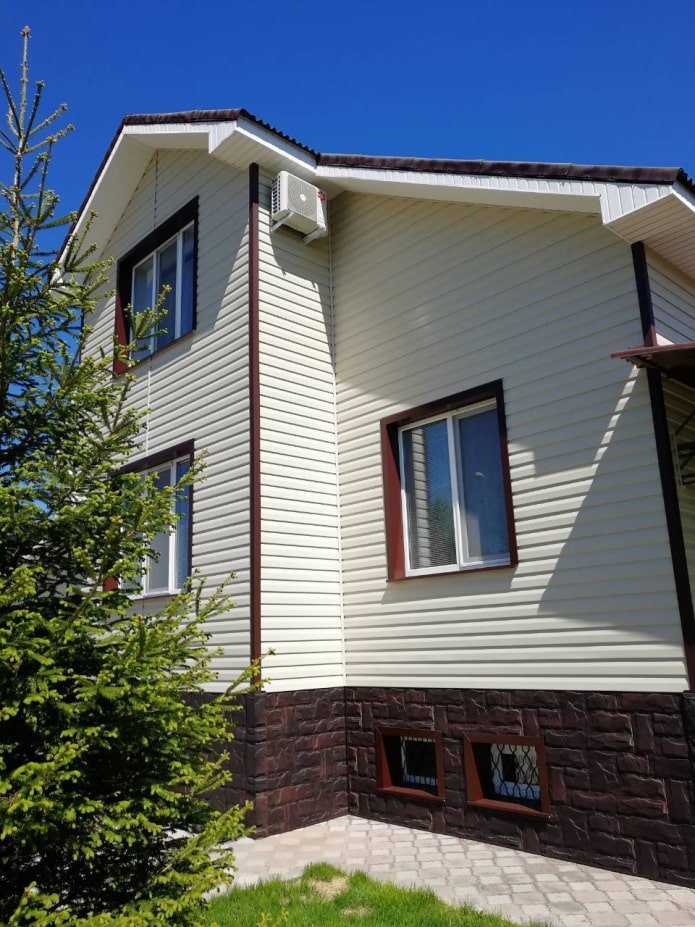
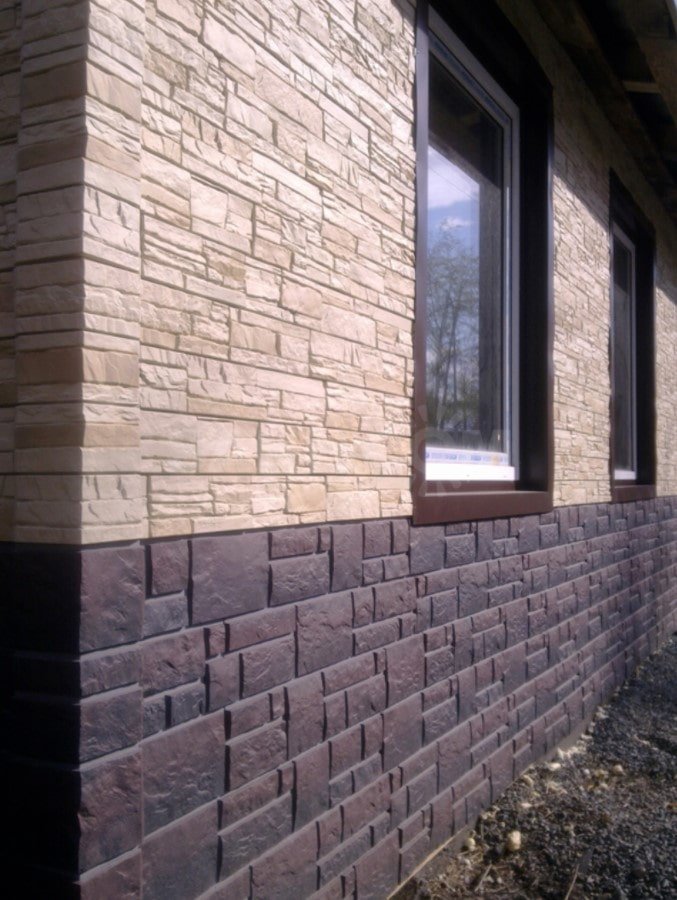
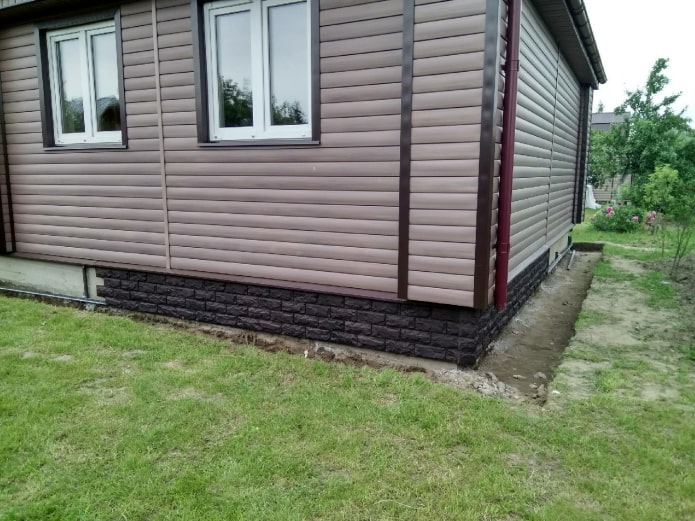
Wood
Natural wood has been used as a finishing material since time immemorial. Eco-friendly, beautiful, easy to process wood has only one big drawback: the need for careful preparation and regular maintenance. Applying impregnations from moisture, fire, insects takes a lot of time and effort, but still does not give a 100% guarantee that the wood will not swell when in contact with water or will not be eaten by pests.
Decorating the basement with natural wood is possible in several options:
- Planken. Profiled board of small thickness.
- Americanka. A type of lining, beveled at an angle – the panels are laid on top of each other with an overlap, forming the texture of stairs.
- False timber. Imitation of square timber.
- Block house. Planks imitating rounded bars.
The elements are installed vertically, horizontally, diagonally, in a herringbone pattern.
Finishing the base with wood is quite a budget option; due to its natural origin, it fits perfectly into the landscape, protects the perimeter of the house from heat loss and moisture (if pre-treated).
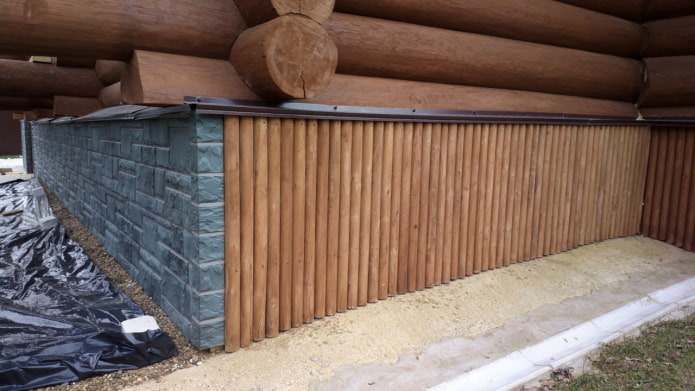
The photo shows a combination of siding and wood
Decorative plaster
In the section of the base, we are talking specifically about decorative compositions suitable for outdoor use: special polymer additives improve the performance properties of the material. Unlike the usual mixture, mineral decorative plaster is moisture-resistant, resistant to temperature changes, and will not crack even under heavy loads.
The plaster is cheaper than its analogues and is easy to apply, so doing the basement finishing yourself can save a lot of money.
Another advantage is a wide range of shades and textures (achieved by adding chips of different diameters). Lamb, bark beetle, fur coat, carpet, rain – in a huge assortment, everyone will find a decorative coating to suit their taste, style or design.
Advice! To avoid problems with the plastered base in the future, choose compositions based on cement with sand or lime.
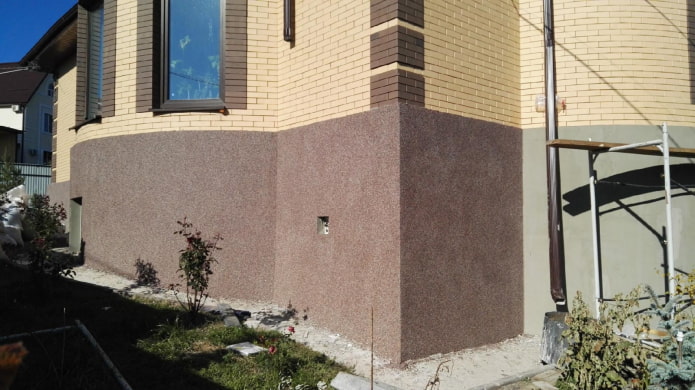
Gabions
Gabions: nets filled with stones will help to create an original design for the lower part of the building. They are stable, durable, can be of any width, thickness, length, height.
The equipment of such a base requires practically no costs: neither physical nor material. All that is needed is to fill the stone nets and attach them to the facade with anchors. No painting, plastering, lathing or other difficulties.
Important! For filling, choose stones slightly larger than the mesh. You can use crushed stone, granite, pebbles and any other durable rocks.
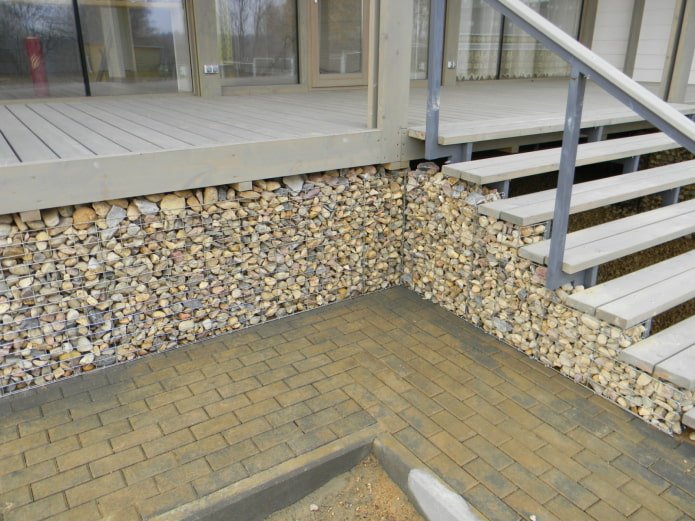
Porcelain tiles
If you cover a low or high basement with sheets of porcelain tiles, the appearance of the building will only benefit: large tiles give buildings a touch of luxury. Porcelain tiles are resistant to mechanical damage, easy to clean, and are not afraid of loads or atmospheric surprises.
But to enjoy all the listed advantages, you first need to attach it to the wall – this is where the nuances begin.
First, the base must be level – you will have to spend time and money on an additional stage. Second, it must be reliable – porcelain tiles, glue, a layer of concrete or plaster for leveling weigh a lot.
A simpler way is to install the base on the lathing. Creating a so-called ventilated facade, when the slabs are attached with special clamps. Then you can make insulation between the cladding and the wall.
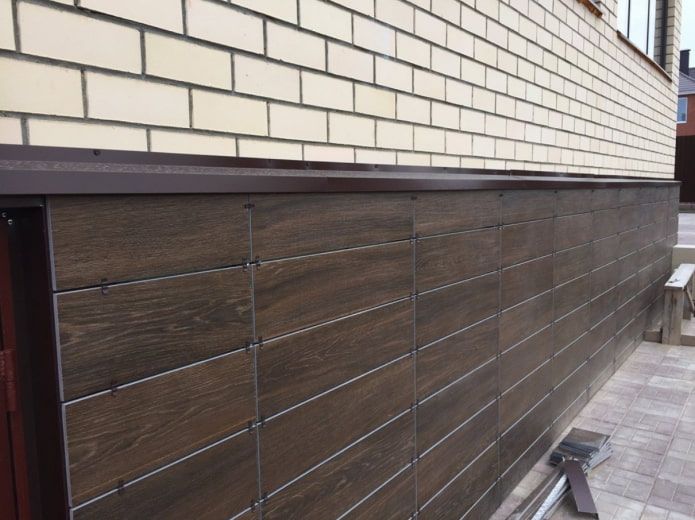
The photo shows a ventilated facade with porcelain stoneware finishing
Clinker tiles
You can get a brick-like base on your house without using the brick itself – there are many imitation options, but one of the most popular is clinker.
Clinker brick or tile is a 100% natural clay-based material, fired in a special oven at a temperature of over 1000 degrees. After such treatment, the clinker does not absorb water, has protection from scratches, chips, serves for many years in heat and cold.
Thanks to its compact size (~240*71 mm, with a thickness of 10-20 mm), the tile is lightweight, can be laid on any, even not the most durable base (unlike its solid counterpart).
The cost of clinker brick is 1.5 times higher than the price of ordinary bricks, but for this money you get a more reliable protective facade coating.
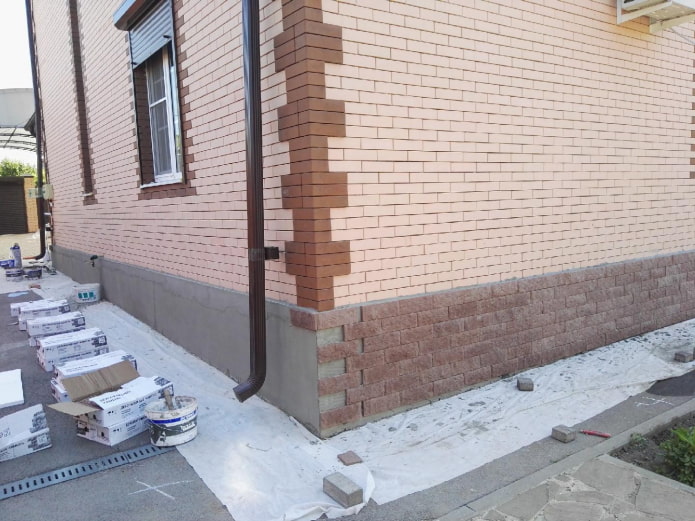
Stone
In finishing the base, you can’t do without stone:
- Natural stone. The type should be chosen based on the effect you want to achieve – bright sandstone looks natural, marble – expensive, pompous, granite – simple but solid.
Advice! When choosing a stone, pay attention to its performance characteristics: it is most reliable to buy material for cladding mined in a region with a similar climate.
- Artificial stone. It is much easier to finish the base with artificial stone – it has a given plane, is easily joined with each other, and in appearance is practically no different from its natural counterpart.
Important! Artificial stone is lighter, which means it can be used not only on monolithic foundations.
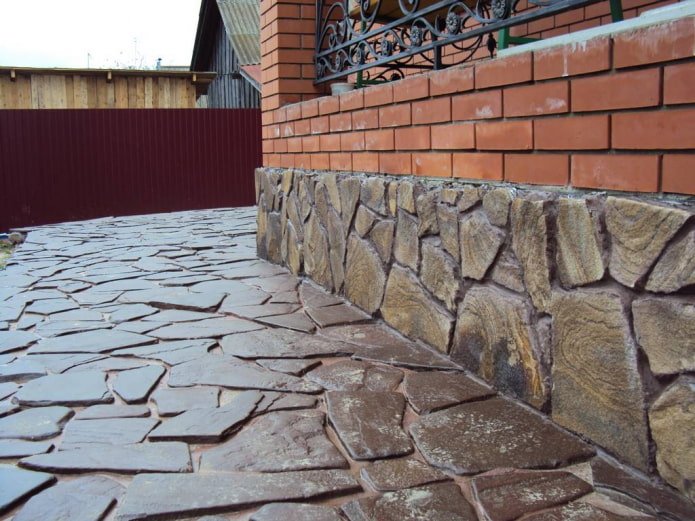
Painting
Painting the walls just above ground level around the house is one of the easiest ways to protect the base surface from premature destruction.
The right base paint should have the following properties:
- Water repellent. It should be understood that moisture that gets into the porous texture of brick or concrete will simply destroy it when frozen or heated.
- Light reflection. Firstly, the paint gives a beautiful tint in the sun. Secondly, it protects the base from direct sunlight.
- Long service life. It is unlikely that anyone would want to repaint the perimeter of the house every couple of years.
- Frost resistance. In the northern regions, this point is especially relevant.
Acrylic, latex, epoxy paints marked “For facades and basements” are distinguished by a wide range of shades and increased resistance to environmental conditions.
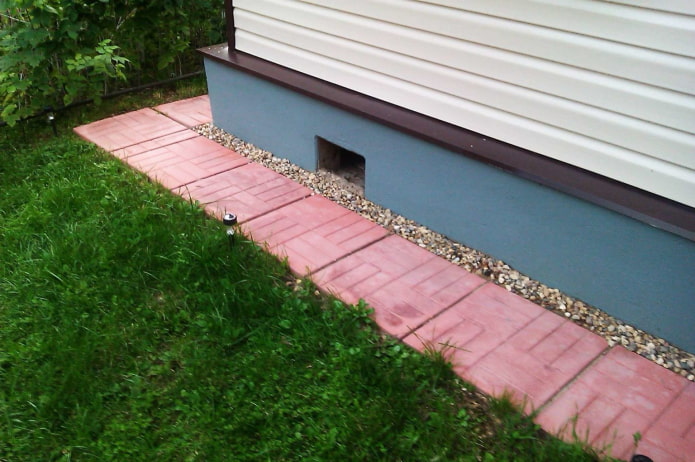
The photo shows a small painted basement
Profile sheet
A budget method for finishing a basement that is easy to implement with your own hands. For basement work, choose a rigid type of corrugated sheet (C13-C21) with a polyurethane coating: this type will not be pressed inward by a snowdrift, will not peel, will not rust from rain, will not fade in the sun.
The fastening principle is profile. Wooden or metal purlins are installed on special plumb lines, and the corrugated sheet is mounted on top. Insulation is placed between the outer finishing of the basement and the wall of the house.
Important! The joints with the ground and walls are additionally insulated to prevent fungus or mold from forming inside.
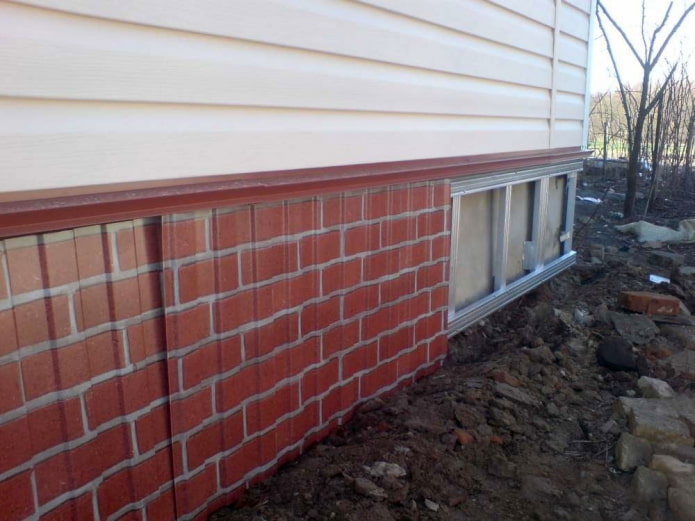
Slate
The material is undeservedly considered obsolete: yes, slate is quite fragile, but at the same time it is not afraid of acids, alkalis, low or high temperatures, does not absorb moisture, does not burn, does not fade under UV rays. Only a blow can destroy it, but the same disadvantage is inherent, for example, in siding or porcelain stoneware.
Experts recommend flat pressed sheets for facade work, which are attached to a wooden or metal base.
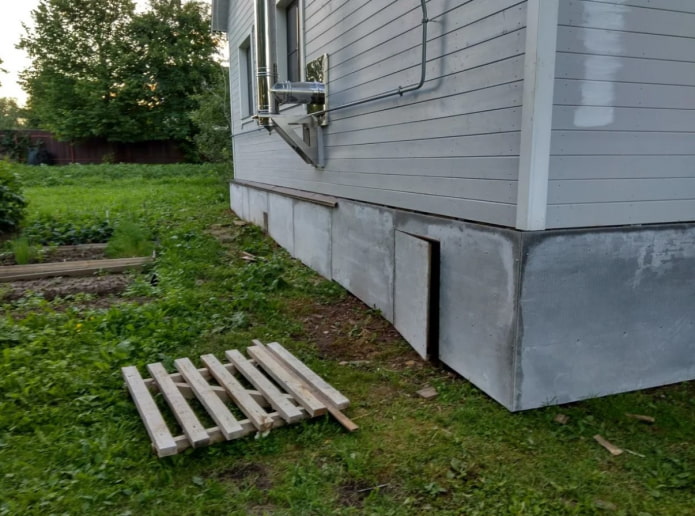
The photo shows an example of using flat slate
Beautiful examples
Natural stone combines strength with decorativeness, opens up a lot of possibilities in home decoration: it is worth widening or narrowing the gap between the elements, as the appearance of the base changes radically.
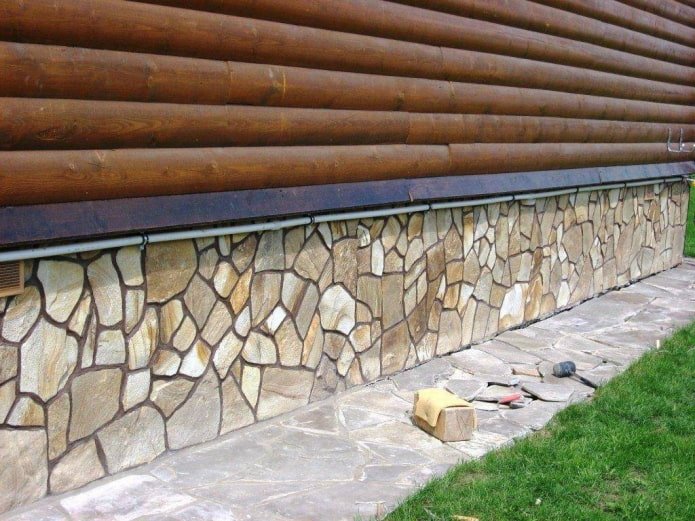
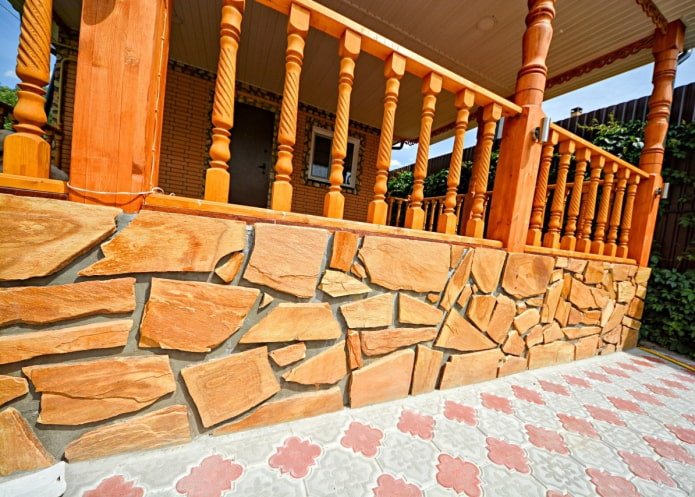
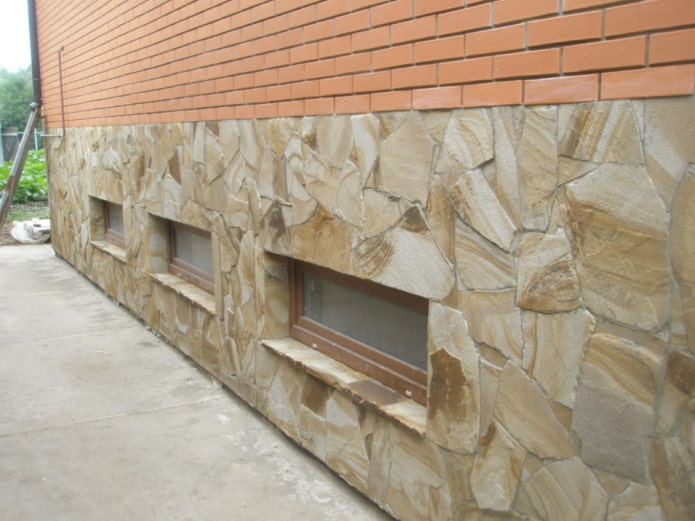
A dark bottom is a win-win option in terms of aesthetics. Chocolate, graphite, wet asphalt look neater, in comparison with the same finish of medium tones.
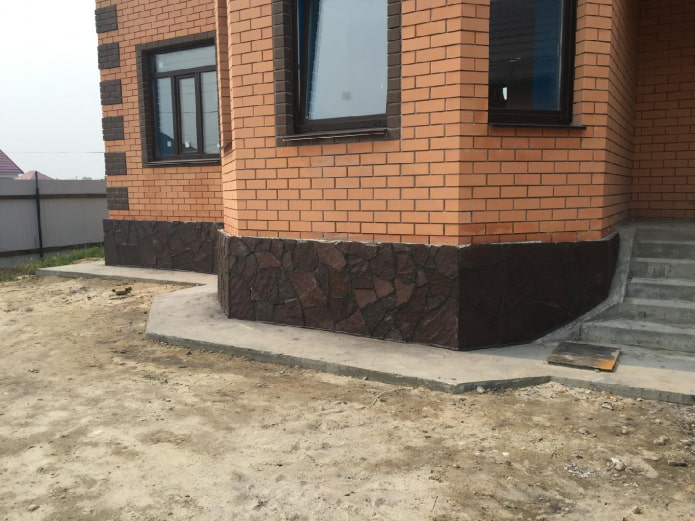
Another universal solution is the bottom of the facade in the color of the path along the house. Light is combined with a bright, dark base. Dark, on the contrary, with the lightest wood or brick.
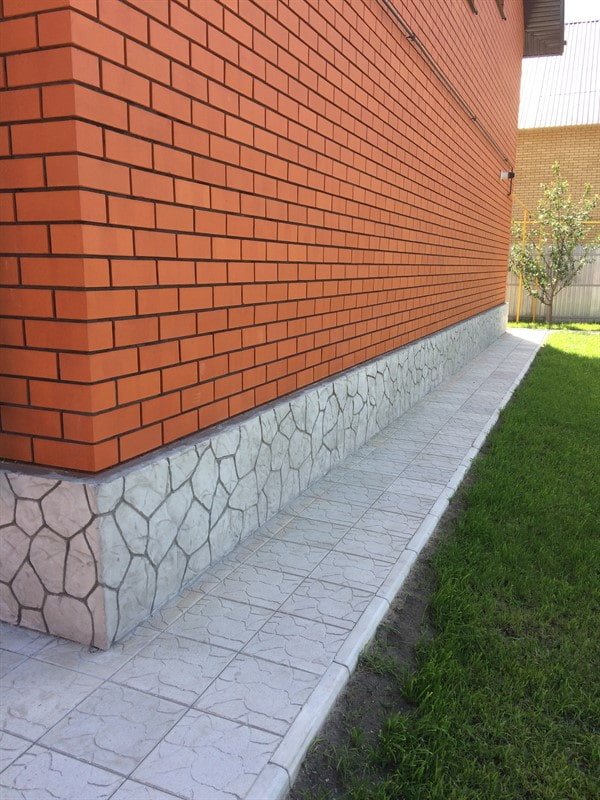
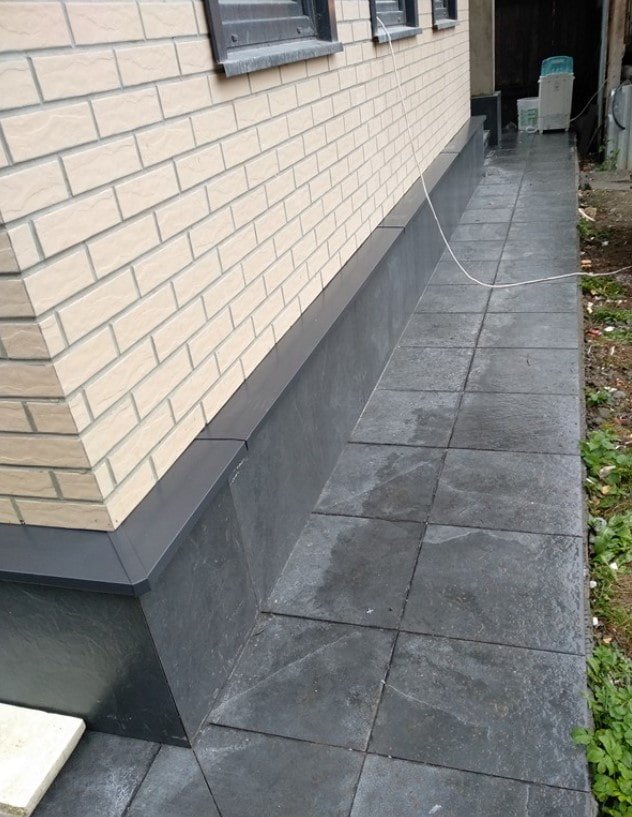
The choice of finishing material is always a compromise between price, beauty, and practicality. The design of the baseboard is no exception, so you can make a final decision only after studying all the possible materials described above.
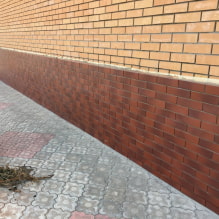
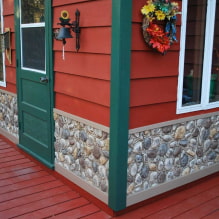
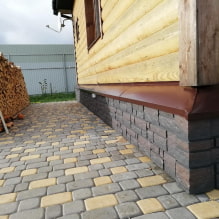
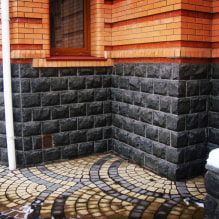
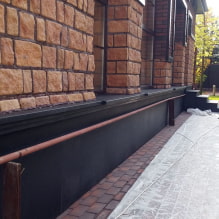
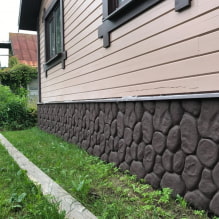
Now reading:
- 70 best photos and popular styles of children’s interior design.
- Installing tiles on the ceiling: preparation stages and step-by-step instructions.
- 15 creative ideas for using the Kallax shelving unit from IKEA for any interior.
- Hyacinths: 21 photos and everything about the rules of care, forcing and planting flowers.
- stylish solutions for hiding a gas pipe in the kitchen without breaking the law.